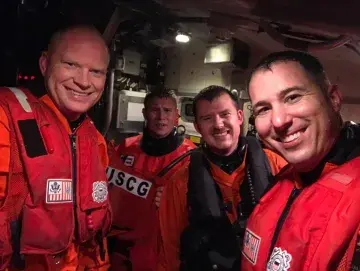
AET2 Jimmy Schwader, a flight mechanic with the Coast Guard Air Station Sitka’s MH-60 Jayhawk helicopter crew and three of his fellow crewmembers – Lt. Justin Neal, Lt. Jonathan Orthman, and AST2 Grant Roberts – received the Department of Homeland Security’s Secretary’s award for Valor for their heroic actions while rescuing a 70-year-old fishing vessel owner and operator from stormy seas. Watch the video of the rescue.
At 5:30 p.m. on November 1, 2020, an alarm sounded at Coast Guard Air Station Sitka, Alaska. An Emergency

Position-Indicating Radio Beacon (EPIRB) registered to fishing vessel Irony had been activated in Earnest Sound, 150 miles southeast of Sitka. The crew departed the air station as a low-pressure storm system battered Southeast Alaska. Read the full story by the U.S. Coast Guard.
In today’s post, we look at the story of this daring rescue through Schwader’s eyes.
“I was amazed how quickly we were able to locate the survivor once we were on scene,” said Schwader, who has served in the Coast Guard for 10 years. “We spotted the strobe of the EPIRB first. Once the pilots were established in a hover near the strobe, we were able to locate the survivor not too far from where his EPIRB was floating in the water.”
According to Schwader, the weather made for an extremely challenging hoist.
“The high winds and 10-12 foot seas made for a challenge to safely deploy the swimmer in the water and deliver the rescue device to the swimmer and survivor,” he recalled. “Conducting this hoist at night made it especially challenging due to the reduced visibility and trying to time the waves so we were not having all that water crash onto the swimmer and survivor while they are connected to the hoist hook.”
Schwader, who grew up as a military dependent, attributes the successful rescue to the team’s, “training, crew dynamics, and the fact that the survivor had a working EPIRB and an immersion suit.”
“If he didn’t have either one of those items, he would have been lost at sea for good,” he said.
Visit the Recognizing DHS Excellence page for more stories about this year’s awardees.
